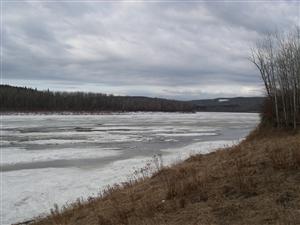Water Quality Indicators: Temperature and Dissolved Oxygen
Water temperature is one of the most important characteristics of an aquatic system, affecting:
- Dissolved oxygen levels. The solubility of oxygen decreases as water temperature increases.
- Chemical processes. Temperature affects the solubility and reaction rates of chemicals. In general, the rate of chemical reactions increases with increasing water temperature.
- Biological processes. Temperature affects metabolism, growth, and reproduction.
- Species composition of the aquatic ecosystem. Many aquatic species can survive only within a limited temperature range.
- Water density and stratification. Water is most dense at 4ºC. Differences in water temperature and density between layers of water in a lake leads to stratification and seasonal turnover.
- Environmental cues for life-history stages. Changes in water temperature may act as a signal for aquatic insects to emerge or for fish to spawn.
The most important source of heat for fresh water is generally the sun, although temperature can also be affected by the temperature of water inputs (such as precipitation, surface runoff, groundwater, and water from upstream tributaries), heat exchanges with the air, and heat lost or gained by evaporation or condensation.
Water temperature fluctuates between day and night (diurnal temperature changes) and over longer time periods (e.g., seasonally). In the spring, snowmelt running into rivers reduces the water temperature to below the ambient air temperature. Permafrost also contributes to cold water runoff when it begins to thaw in June or July, and its meltwater seeps into the river.
Water temperature varies along the length of a river with latitude and elevation, but can also vary between small sections only metres apart, depending on local conditions. For example, a deep, shaded pool is cooler than a shallow, sunny area. In lakes, temperature can vary with depth, according to the level of solar radiation penetration and mixing characteristics. The temperature of surface water is usually between 0ºC and 30ºC, although the temperature of hot springs may exceed 40ºC.
Human activities affecting water temperature can include the discharge of cooling water or heated industrial effluents, agriculture and forest harvesting (due to effects on shading), urban development that alters the characteristics and path of stormwater runoff, and climate change.
Dissolved Oxygen
The amount of oxygen that dissolves in water can vary in daily and seasonal patterns, and decreases with higher temperature, salinity, and elevation. The maximum solubility of oxygen in water at 1 atm pressure (standard air pressure at sea level) ranges from about 15 mg/L at 0ºC to 8 mg/L at 30ºC—that is, ice-cold water can hold twice as much dissolved oxygen as warm water (Wetzel 2001). Dissolved oxygen comes from the atmosphere and from photosynthesis by aquatic plants, and is depleted through chemical oxidation and respiration by aquatic animals and microorganisms, especially during the decomposition of plant biomass and other organic material.
Surface water, near the water-atmosphere interface and with sufficient light for photosynthesis, is generally saturated or even supersaturated with oxygen. Deeper water receives oxygen through mixing by wind, currents, and inflows. Mixing and aeration also occur at waterfalls and rapids. Dissolved oxygen can be reduced to very low levels during the winter months when water is trapped under ice.
Dissolved oxygen is essential for a healthy aquatic ecosystem. Fish and aquatic animals need the oxygen dissolved in the water to survive. The need for oxygen depends on the species and life stage; some organisms are adapted to lower oxygen conditions, while others require higher concentrations. Dissolved oxygen can affect the solubility and availability of nutrients, which can be released from sediments under conditions of low dissolved oxygen (B.C. MELP et al. 1998).









